They were starving, sick. Many were untrained. Their weapons were obsolete. And their top general lived elsewhere. Bataan’s defenders were truly on their own.
By Richard Sassaman
Major Marshall Hurt was not having a good morning. Around midnight, he and Colonel Everett Williams, both bachelors on Major General Edward King’s staff, had volunteered to try to find a Japanese officer who would accept the surrender of King’s 75,000 American and Filipino defenders of the Bataan peninsula.
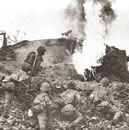 The next hours of the Battle of Bataan were filled with noise and confusion. “The roads were jammed with soldiers who had abandoned arms and equipment in their frantic haste to escape from the advancing Japanese infantry and armored columns and the strafing planes overhead,” wrote Louis Morton in his book The Fall of the Philippines (1953). At 2 a.m. on April 9, 1942, Filipino and American troops who had been trapped on the Bataan peninsula of the Philippines’ Luzon island for three months began exploding their TNT storehouses and hundreds of thousands of rounds of small-arms ammunition and artillery shells to keep them out of Japanese hands. Adding to the chaos, just before midnight a severe earthquake had rumbled through the area.
The next hours of the Battle of Bataan were filled with noise and confusion. “The roads were jammed with soldiers who had abandoned arms and equipment in their frantic haste to escape from the advancing Japanese infantry and armored columns and the strafing planes overhead,” wrote Louis Morton in his book The Fall of the Philippines (1953). At 2 a.m. on April 9, 1942, Filipino and American troops who had been trapped on the Bataan peninsula of the Philippines’ Luzon island for three months began exploding their TNT storehouses and hundreds of thousands of rounds of small-arms ammunition and artillery shells to keep them out of Japanese hands. Adding to the chaos, just before midnight a severe earthquake had rumbled through the area.
Leaving at 3:30 a.m., on a schedule they hoped would put them on the front lines about dawn, the two officers headed north on Bataan’s East Road against a tide of what Hurt later described as “crouching, demoralized, beaten foot soldiers” fleeing south. Their route led “past blown-up tanks, burning trucks, broken guns.” Their car soon became useless.
Williams hopped on the back of a motorcycle and rode off, leaving Hurt to make his way on foot. When the two reunited, Williams somehow had commandeered another jeep, along with a driver, and they tried again. Except for “the chattering teeth of our driver,” Hurt said, things were quiet—until they crossed into enemy territory and several dozen Japanese soldiers rushed at them, screaming. Waving a white flag made from a bed sheet, while avoiding raised Japanese bayonets, the officers used sign language to explain their mission. They were taken to Major General Kameichiro Nagano, commander of the Japanese 21st Infantry Division, who agreed to meet King if Hurt would go back and get him.
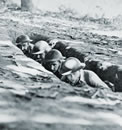 Escorted part of the way by Japanese tanks, Hurt returned to headquarters around 9 a.m., then immediately headed north again with King—wearing his last clean uniform—and two other aides in a pair of jeeps prominently displaying white flags. Still, every 200 yards or so, Morton wrote, King’s small group “was forced to jump hastily from the vehicles and seek cover in a ditch or behind a tree” from Japanese planes who “came in at very low altitude, [and] sprayed the road with their machine guns or dropped a string of small bombs.” Before long “the general’s uniform was as disheveled as those he had left behind,” and it took the men two hours to drive three miles. Few things had gone right in 1942 for the defenders of Bataan, and now they were finding it almost impossible even to surrender.
Escorted part of the way by Japanese tanks, Hurt returned to headquarters around 9 a.m., then immediately headed north again with King—wearing his last clean uniform—and two other aides in a pair of jeeps prominently displaying white flags. Still, every 200 yards or so, Morton wrote, King’s small group “was forced to jump hastily from the vehicles and seek cover in a ditch or behind a tree” from Japanese planes who “came in at very low altitude, [and] sprayed the road with their machine guns or dropped a string of small bombs.” Before long “the general’s uniform was as disheveled as those he had left behind,” and it took the men two hours to drive three miles. Few things had gone right in 1942 for the defenders of Bataan, and now they were finding it almost impossible even to surrender.
The last month of 1941 had been almost as bad, beginning on December 8 with a surprise Japanese bombing raid on Clark Field, Luzon, 60 miles northwest of Manila. That raid had been as shocking and destructive as the attack nine hours earlier at Pearl Harbor (Hawaii and Luzon are on opposite sides of the International Date Line). The Allied war plan for the defense of the Philippines, codenamed Orange, called for a strategic retreat across Manila Bay to Bataan, where, protected by superior air power, the Allies could hold out until reinforcements arrived from Hawaii. But with the losses of planes on Luzon and ships at Pearl Harbor within several hours of each other, the plan had no hope of success.
General Douglas MacArthur, commander of the US Armed Forces in the Far East (USAFFE) since July, overestimated his Filipino soldiers and underestimated the Japanese. He wanted to try a more aggressive defensive strategy to stop the invaders on the island’s beaches. When that failed dismally, with Filipinos fleeing the battle, he switched back to the Orange plan on December 23 and got his men to safety on Bataan, while moving USAFFE headquarters to the fortress island of Corregidor a few miles offshore. Unfortunately, most of the army’s supplies and food, which had been dispersed from central storage to forces on the beaches, had to be left behind during the hasty retreat. Without food, air cover, or much hope of reinforcement, the American and Filipino servicemen had moved onto Bataan, in the words of one Japanese officer, “like a cat entering a sack.” Essentially, the battle was already over except for the shooting.
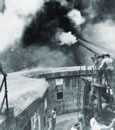 The 75,000 defenders of Bataan, while technically part of the US Army, were three-quarters Filipino. Unfortun-ately, with the exception of the highly skilled scouts of the Philippine Division, the bulk of the soldiers were untrained, unequipped, and (as the fighting at the beaches had showed) uninterested in hanging around once a battle started. “These people, you could be with them and the next thing you’d be by yourself,” one private said. A corporal added, “The native infantry had a bad case of the runs. They had a million excuses” to leave the front lines. While retreating, he said, they would pass holding up two fingers in a V for Victory gesture. Americans referred to the gesture as “V for Vacate.” A division commander reported that the native troops did only two things well: “one, when an officer appeared, to yell attention in a loud voice, jump up and salute; the other, to demand three meals per day.”
The 75,000 defenders of Bataan, while technically part of the US Army, were three-quarters Filipino. Unfortun-ately, with the exception of the highly skilled scouts of the Philippine Division, the bulk of the soldiers were untrained, unequipped, and (as the fighting at the beaches had showed) uninterested in hanging around once a battle started. “These people, you could be with them and the next thing you’d be by yourself,” one private said. A corporal added, “The native infantry had a bad case of the runs. They had a million excuses” to leave the front lines. While retreating, he said, they would pass holding up two fingers in a V for Victory gesture. Americans referred to the gesture as “V for Vacate.” A division commander reported that the native troops did only two things well: “one, when an officer appeared, to yell attention in a loud voice, jump up and salute; the other, to demand three meals per day.”
Communication between the troops was difficult. “Over sixty-five dialects are spoken in the Islands,” wrote Morton. “In many units there was a serious language barrier, not only between the American instructors and the Filipinos but also among the Filipinos. The enlisted men of one division spoke the Bicolanian dialect, their Philippine officers usually spoke Tagalog, and the Americans spoke neither.”
To make matters worse, the Filipinos’ weapons and munitions dated from World War I. Only one in three mortar shells would explode, and maybe one in five of the hand grenades. Many rifles had broken extractors, so after each bullet was fired, the shell case had to be pushed out of the gun with a piece of bamboo. The more modern M-1 rifles “became highly undependable” when dirty, said one private. “We got tired of pulling the trigger and having nothing happen.”
One more misfortune for the defenders of Bataan was the weather. It was the dry season in the Philippines, and the lack of rain, choking dust storms, temperatures usually above 90 degrees, and near 100-percent humidity made for an unpleasant environment even when the enemy wasn’t attacking, especially when combined with the tropical snakes, rats, and swarming insects.
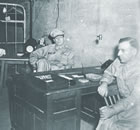 The Japanese entered Manila on January 2, their invasion mostly unopposed. Things had gone so well for Lieutenant General Masaharu Homma, head of the Japanese 14th Army, that he became overconfident and started making mistakes. Intelligence reports indicated that only a ragged army of 25,000 remained to defend Bataan, so Homma allowed 15,000 of his finest troops, the 48th Division, to be transferred to the Dutch East Indies. Their replacements, the 6,600 men of the 65th Brigade, were an untested, poorly trained reserve unit.
The Japanese entered Manila on January 2, their invasion mostly unopposed. Things had gone so well for Lieutenant General Masaharu Homma, head of the Japanese 14th Army, that he became overconfident and started making mistakes. Intelligence reports indicated that only a ragged army of 25,000 remained to defend Bataan, so Homma allowed 15,000 of his finest troops, the 48th Division, to be transferred to the Dutch East Indies. Their replacements, the 6,600 men of the 65th Brigade, were an untested, poorly trained reserve unit.
Homma also had a new opponent to fight—the peninsula itself, more than 75 percent impenetrable jungle. “Bataan is ideally suited for defensive warfare,” Morton wrote. “It is jungled and mountainous, cut by numerous streams and deep ravines, and has only two roads adequate for motor vehicles.” The peninsula was a breeding ground for numerous diseases—malaria, dysentery, typhoid, dengue fever—that attacked both sides without prejudice.
By January 7, the Allied main defense line had been thrown up from Mauban on the west coast to Abucay on the east, anchored in the middle by the 4,222-foot-high extinct volcano Mt. Natib. The terrain around Natib was so rugged that the Allies left a five-mile gap in the center of their line, thinking the Japanese could never get through. When the Japanese finally did slog through several weeks later, the Allies retreated and reformed across a narrower section of the peninsula, from Bagac on the west to Orion on the east.
Battle forces moved slowly forward and back—not unlike the trench warfare of World War I. In one instance, Philippine scouts fought for four days to gain 40 yards of territory. It was hard even to tell the armies apart. Donald Young wrote in his book The Battle of Bataan (1992) that the Japanese 141st Infantry was attacked by soldiers of the Japanese 9th Infantry, who, “after seven days in the Natib forest, like a blind, hungry rattlesnake, were striking at anything that moved.”
On January 22, as the Bagac-Orion line was being established, the Japanese also launched an invasion down the west coast of Bataan. Ordered to converge on Caibobo Point, behind enemy lines, the 1,200 men—mostly seasick, sailing in overcrowded barges in the dark, without proper maps—became separated into two groups. One group landed 7 miles south of its target, and the other, 10.
Most of the defenders onshore, under the command of Brigadier General Clyde Selleck, had no infantry training. They included airmen with no planes to fly, members of a naval battalion without ships to sail, and former native policemen. Many of the men were, as one captain put it, “just remotely acquainted with their rifles.” One carpenter’s mate second class explained that the Filipinos “didn’t even know which end of the gun to fire. The rest of us didn’t know how to fire a gun if the safety was on.”
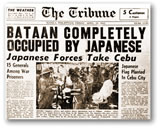 For the next three weeks, as the Japanese reinforced their original landing parties, the fledgling Filipino infantrymen fought along Bataan’s southwest coast on headlands named Longoskawayan, Quinauan, Anyasan, and Silaiim, in combat that became known as the Battle of the Points. They used a patchwork collection of weapons. Young described “two air-cooled .50-caliber machine guns that had been salvaged from a wrecked P-40 [US fighter]. Since there were no mounts for the bulky weapons, each gun was first loaded and then strapped to the back of a man, who, in turn, was followed closely down the trail by the gunner. To go into action, the man carrying the 95-pound .50 literally became a human gun-mount, dropping to all fours and then aiming himself in the general direction of the enemy. The gunner, in the meantime, would crawl up behind and begin firing.”
For the next three weeks, as the Japanese reinforced their original landing parties, the fledgling Filipino infantrymen fought along Bataan’s southwest coast on headlands named Longoskawayan, Quinauan, Anyasan, and Silaiim, in combat that became known as the Battle of the Points. They used a patchwork collection of weapons. Young described “two air-cooled .50-caliber machine guns that had been salvaged from a wrecked P-40 [US fighter]. Since there were no mounts for the bulky weapons, each gun was first loaded and then strapped to the back of a man, who, in turn, was followed closely down the trail by the gunner. To go into action, the man carrying the 95-pound .50 literally became a human gun-mount, dropping to all fours and then aiming himself in the general direction of the enemy. The gunner, in the meantime, would crawl up behind and begin firing.”
The Japanese had come so far south that even the guns on Corregidor could be used against them, making this the first time a major coastal battery had seen action since the American Civil War. In the end, the defenders, on higher ground, obliterated the invaders. By February 13, only about three dozen of the 2,000 Japanese soldiers who fought in the Battle of the Points were still alive.
While the fighting raged on the southwest coast, the main Japanese force attacked the reserve battle line just below the Pilar-Bagac Road. That line now was the main point of defense in what would be called the Battle of the Pockets.
The Allies now had 50 percent less territory to defend and, with no volcano in the middle of their line, manned a continuous barrier across the entire peninsula for the first time. About 1,000 Japanese broke through the line anyway, but soon got outflanked and trapped in three different places (the Little, Big, and Upper pockets). By February 17, when the Orion–Bagac line reformed after three weeks of bitter fighting, fewer than 400 of the invaders had made it back to their own side alive. Also by then, Homma had decided that enough was enough. In just over a month, almost 3,000 of his men had been killed, at least 4,000 more were wounded, and as many as 12,000 were sick or dying from malaria, beriberi, and dysentery.
At a staff meeting on February 8, Homma asked his staff for advice. One senior officer said their forces should be attacking on the relatively flat east coast of Bataan instead of the rugged west coast. Lieutenant General Masami Maeda, Homma’s chief of staff, pointed out that they didn’t really have to do anything, since the defenders were running out of food and soon would be starved into submission. “Although there may have been some merit in Maeda’s proposal,” wrote Richard Connaughton in his book MacArthur and Defeat in the Philippines (2001), “it would have led to an inglorious and hollow victory.” Homma, already “having failed to achieve his mission in time…, faced up to the embarrassment of asking Tokyo for reinforcements.” As Homma awaited the arrival of fresh troops, Japanese attacks on the Bataan front ceased for the next six weeks. Incredibly, the unprepared, outgunned, starving defenders were winning the struggle.
The pause in the fighting gave the Allies on Bataan free time to obsess about food. “When you’re in and out of heavy hand-to-hand combat, being hungry is really not the point,” one corporal told Knox. But during the lull, said a private, “not only did you talk about food, you dreamed about food, you fantasized about food.”
Rations, cut in half since the first week of January, were cut again, and then again, so that in addition to the ever-present tropical diseases the men began suffering from malnutrition and vitamin deficiencies. “To supplement meager rations—less than a cup of rice daily per man—they ate mule, dog, cat, lizard, monkey, and iguana meat, and gnawed on roots, bark, and leaves,” wrote William Breuer in his book Retaking the Philippines (1986). The 250 horses and 48 pack mules of the 26th Regiment ended up, over the weeks, as “cavalry steak.” After they were gone, one corporal said, “we killed and ate snakes, cats, monkeys, and anything else that had meat on it. The horse meat, I thought, was very good.” He did not feel the same way about the native water buffalo, remarking, “I remember the first time I ate carabao, it tasted just like the mud it used to wallow in.” One private said, “Horse meat is surprisingly good,” but he later balked at eating monkey when he found “a little old bleached hand that looked exactly like a baby’s” in the pot. One colonel said, “I can recommend mule. The pony was tougher but better flavored than the carabao. Iguana was fair.”
The major development in March came on the 11th, when MacArthur, his wife, and four-year-old son, plus members of his staff, left Corregidor in four battered PT (patrol torpedo) boats led by Lieutenant John Bulkeley. His daring escape took him ultimately to Australia, where he became supreme commander of the newly formed Southwest Pacific Area. MacArthur had not wanted to abandon the Philippines, but directly ordered by President Franklin D. Roosevelt to leave, he was stuck in the unenviable position of having either to abandon his men or to disobey his commander-in-chief. His decision to abide the order, coupled with his behavior leading up to his departure, did not help his case with his GIs. “Though the Filipino soldiers clung to their devotion to MacArthur, the Americans more and more began deriding him,” said a lieutenant from the 26th Cavalry. “As ammunition and food ran out, and as the weeks passed with none of the promised relief, they made up derisive songs and jokes about the general….” Some men sang a parody to the tune of “The Battle Hymn of the Republic”:
Dugout Doug MacArthur lies a-shakin’ on the Rock
Safe from all the bombers and from any sudden shock.
Dugout Doug is eating of the best food on Bataan
And his troops go starving on.
The criticism was cruel, but it was true that McArthur had visited Bataan from Corregidor only once during the fighting, on January 10. The men now sensed that with him gone, they were expendable. Their feeling was summed up well by Frank Hewlett, the only US war correspondent left in the islands:
We’re the battling bastards of Bataan.
No mama, no papa, no Uncle Sam,
No aunts, no uncles, no cousins, no nieces,
No pills, no planes, no artillery pieces
And nobody gives a damn.
The end came quickly. On Good Friday, April 3, a heavily reinforced and rested Japanese army, supported by endless artillery barrages and overwhelming air support, began to break through the defense lines on Bataan. MacArthur sent word from Australia on April 4 that the best time to attack was when food supplies ran out completely. A few weeks earlier, Lieutenant General Jonathan Wainwright, who replaced MacArthur on Corregidor, had promised Roosevelt that Bataan would resist “as long as an American soldier or an ounce of food and a round of ammunition remains.”
On the 7th, Wainwright ordered King to counterattack, an action that had so little likelihood of success that King sent his chief of staff, Brigadier General Arnold J. Funk, to confirm it. Did Wainwright realize, Funk asked, that everything on Bataan—food, equipment, ammunition, men—was exhausted? More than 20,000 sick and wounded soldiers were hospitalized. About 80 percent of the troops had malaria, 75 percent dysentery, and maybe 35 percent beriberi. “I understand the situation,” Wainwright assured Funk. “God help you all over there. I have done all I can.” He repeated his order to attack.
April 8 was “the worst day,” said a private in the medical corps. “The Jap bombers came over in waves. Then they’d send in the fighters to strafe us…. Nobody knows how many men were killed those last days. They have no earthly idea.” An infantry private said, “Thousands of rounds an hour [were] falling in an area not more than a mile in depth. We lost every gun, every truck, and every piece of equipment we had…. At first it was every unit for itself. Later, it boiled down to every man for himself.” A private with the engineers summed it up as “a miserable damn time.”
When all resistance had crumbled into massive chaos and confusion, it turned out that, contrary to the line in Hewlett’s verse, someone did give a damn about “the battling bastards of Bataan.” King took inventory of the men he was supposed to lead in the ordered counterattack. How many were combat-ready—in other words, how many had the strength to walk 100 yards holding a weapon and then fire it? The answer came back: maybe 15 percent.
Knowing he had only one chance to save his tired, starving, and ailing men, King decided to disobey his orders and surrender. He realized that he was leaving himself open to court-martial and that his men could end up spending the rest of the war in abysmal prison camps. But at least they wouldn’t face certain, immediate slaughter.
Morton described King as “soft-spoken, modest, innately courteous to all ranks…, an extremely able soldier of high intellectual caliber.” A Georgia native, the grandson and nephew of men who fought for the Confederacy, King rode to the surrender meeting thinking of fellow Southerner Robert E. Lee, who 77 years earlier had ridden to Appomattox Court House, Virginia, to surrender his Army of Northern Virginia and end the Civil War. King believed he now knew what Lee meant when he said, “There is nothing left for me to do but to go and see General Grant, and I would rather die a thousand deaths.”
King’s courageous surrender, sadly, was not the last unfortunate event for the Filipino and American defenders of the Philippines. Immediately after their capture, they were forced into the horrors of the Bataan Death March. Not long after that, Wainwright surrendered Corregidor, and all the defenders of the Philippines faced death or long, hard years of imprisonment.
The reality of the American effort in the Philippines was harsh. “The plain fact stands out that the greatest industrial power on earth, the United States, was impotent in the defense of the Philippines…,” wrote Brigadier General Bradford Chynoweth, in command on the Visayan islands. “In full truth, it was an unsavory mess. It was a tragedy, a disgrace, a disaster.” In the book MacArthur and Wainwright: Sacrifice of the Philippines, author John Jacob Beck wrote, “A Filamerican force of 140,000 men had been defeated. More than seven million Filipinos had been enslaved by the invader. The United States had failed in its political and moral commitment to defend the Philippines, and more than 20,000 American officers and enlisted men had been either killed or captured. It was the worst military defeat in the history of the US armed forces.”
Despite the obvious failings, the American effort was not completely in vain. “The valiant defense of the Philippines had several important consequences,” wrote US Army historian Jennifer Bailey. “It delayed the Japanese timetable for the conquest of south Asia, [and] became a symbol of hope for the United States in the early, bleak days of the war.” MacArthur’s chief clerk, Paul Rogers, wrote, “The officers and men who fought on Bataan believed in the end that they had been defeated. Be that as it may, they had fought according to plan in a battle they were never expected to win. They were expected only to hold out for three months, and that is precisely what they did.”
Copyright 310 Publishing, LLC. All rights reserved.



FOLLOW US »
